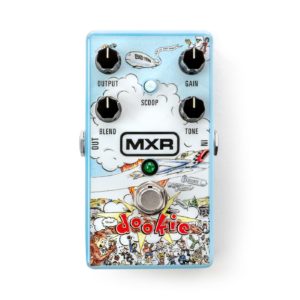MXR DD25 Dookie Drive Pedal- review
 Back in the early 1990s there was a major shift with the state of rock music in the mainstream. Grunge and alternative rock came into the forefront, and knocked hair and glam metal from the top of the rock food chain. Following on from grunge was punk rock. In some ways an extension of the vibe that grunge brought, punk just made things faster and at times more raw. Greenday are one of the most successful bands to have emerged during this time. Combining speedy raw melodic guitar hooks, and lyrics that spoke to a disaffected youth, Greenday jumped out of the underground, and were thrust into the limelight.
Back in the early 1990s there was a major shift with the state of rock music in the mainstream. Grunge and alternative rock came into the forefront, and knocked hair and glam metal from the top of the rock food chain. Following on from grunge was punk rock. In some ways an extension of the vibe that grunge brought, punk just made things faster and at times more raw. Greenday are one of the most successful bands to have emerged during this time. Combining speedy raw melodic guitar hooks, and lyrics that spoke to a disaffected youth, Greenday jumped out of the underground, and were thrust into the limelight.
I was a young teenager at the time, and it would not be an understatement that Greenday, and the release of their major label debut, Dookie, were a major gateway that got me into punk rock. Bands like Greenday showed me that I didn’t have to have the shreddiest licks to deliver a message, and convey an emotion, and this shifted what my focus was while learning to play the guitar.
Whilst I have moved on a little from Greenday as a major influence, I still consider Dookie a benchmark for great sounding rock guitars. Billie Joe Armstrong used two heavily modified Marhsall amplifiers, named Pete and Meat to record Dookie, and subsequent albums. Pete provided a cleaner, more mid-range sound, while Meat gave a heavier, more scooped tone. These two amps were blended in various ways to create a great range of cleaner and heavier guitar tones on Dookie.
To celebrate the 25th anniversary of this breakthrough album, Jim Dunlop and Billie Joe Armstrong teamed up to create the MXR DD25 Dookie Drive distortion pedal. First announced at Winter NAMM 2019, the Dookie Drive got teenage me very excited. Combining the iconic Dookie artwork with a compact pedal sporting two “amps”, and a blend control, just the look of the pedal made me want to have it. Fast forward to mid-year, and proper sound samples started to surface. Not only did the Dookie Drive look amazing, it looked as though it would be a fantastic sounding distortion pedal too. I knew that I had to get my hands on one, and my wishes came true on my birthday.
I tested the Dookie Drive through my Blackstar HT-5 amplifier, through a 1×12″ cabinet sporting a Celestion Vintage 30 speaker. The main test guitar was my Squier Bullet Strat, which is loaded with DiMarzio Paul Gilbert Injector bridge and neck pickups.
The Dookie Drive has a fairly simple control set to deal with. Output and Gain across the top, and Blend and Tone below. In the middle is a Scoop button, which allows the user to scoop the mids a reasonable amount, and below that is a bright green LED, letting you know when the pedal is engaged. Underneath the hood are two trim pots that allow the user to adjust the output and drive of the Pete side of things.
Plugging into the Dookie Drive and switching my amp to the clean channel, I dove into one of my favourite Greenday songs, Basket Case, to dial in a “Dookie” approximation. What blew my teenage mind was how easy it was to dial in a fantastic sound that was pretty dammed close to those great tones found on the album. The tone control is simple, yet effective, and allows you to tailor the tone to suit your amplifier’s tone circuit to get the desired sounds out of the pedal. The gain control offers a large range of distortion, and the blend control gives you a really nice approximation of a two amp setup being mixed through a mixing console.
Now it’s all well and good that the Dookie Drive can do a great replication of those classic sounds found on Greenday’s trailblazing albums, but a one trick pony of a pedal would not really suffice for most people. Thankfully the Dookie Drive offers a large array of tones, from gritty edge of breakup, through to big heavy, almost fuzzy distortion. The Scoop button allows you to lower the midrange frequencies in the tone circuit, giving a bit more flexibility to achieve punchier tones.
The Dookie Drive can also handle overdrive and boost duties, thanks to the wide gain range, tone stack and the blend control, giving you tones ranging from clean boost to massive cutting overdrive mayhem on top of an already distorted amplifier.
Overall, the MXR DD25 Dookie Drive is an amazing pedal, not only for the Greenday fan, but also for anyone looking for a versatile pedal that can dial up great rock tones in a distortion pedal setting, and double up as a formidable overdrive and boost pedal. If any of this sounds like something you are a looking for then definitely check out the Dookie Drive.

Leave a Reply